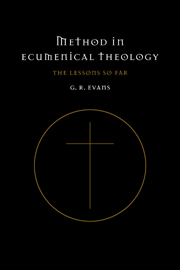Book contents
- Frontmatter
- Contents
- Dedication
- Preface
- Abbreviations
- Introduction: the ‘winter of ecumenism’?
- I What is ecumenical theology?
- 2 Changing attitudes and stages in ecumenism
- 3 Communication and dialogue
- 4 Ecumenical language
- 5 Historical method
- 6 The process in close-up
- 7 Ecumenical reception
- Conclusion
- Index
3 - Communication and dialogue
Published online by Cambridge University Press: 02 September 2009
- Frontmatter
- Contents
- Dedication
- Preface
- Abbreviations
- Introduction: the ‘winter of ecumenism’?
- I What is ecumenical theology?
- 2 Changing attitudes and stages in ecumenism
- 3 Communication and dialogue
- 4 Ecumenical language
- 5 Historical method
- 6 The process in close-up
- 7 Ecumenical reception
- Conclusion
- Index
Summary
CHURCHES AND PERSONS
It is one of the paradoxes of ecumenical encounter that although what is happening is a meeting of churches, that can happen only in and through the meeting of human individuals. We have already noted that churches are not persons in the same way that individuals are persons, although the Church has a corporate identity as the body of Christ. The problem is that persons do not always keep clear, as they talk, the distinction between their positions as individuals and their positions as representatives of an ecclesial body. ‘I cannot put my name to this,’ says a member of a commission, speaking in conscience as a person, as much as because he fears to ‘betray a constituency’ if he does.
We have not got very far in exploring the relationship between personal change of attitude to other churches and affirmation of mutual respect, and that which is now possible in and between communities; for communities are made up of persons and must carry their members with them when they ‘move’. J. M. R. Tillard writes (in connection with justification by faith) on the ecumenical problem of ‘collective faith’. The bulk of work done over the centuries since Luther has been devoted to the working of justification by faith, in the individual and a Deo solo? But in baptism the candidate becomes a member of the Church.
- Type
- Chapter
- Information
- Method in Ecumenical TheologyThe Lessons So Far, pp. 66 - 88Publisher: Cambridge University PressPrint publication year: 1996



